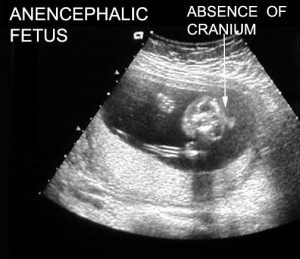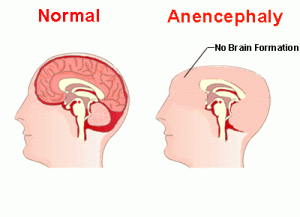“Is my baby healthy? Ten fingers? Ten toes?”, these are prime examples of questions that new soon-to-be mommies should be asking. The process of conception, pregnancy, and becoming a mother is supposed to be beautiful and joyous. Imagine if the answerer to these questions wasn’t a positive “yes”; Picture this, your doctor comes walking in and says that the answer is “No, I’m sorry to say but, you’re baby has anencephaly.”
Anencephaly, defined by MedicineNet.com, is a fetus is born with little to no brain or skull. It is an extremely rare condition, affecting only 3 in 10,000 babies born each year. The reason why this number is so low is because most babies with neurological defects miscarry. Looking at the frequency, process, causes, and what happens to the baby after birth; we will be able to better understand anencephaly.
Occurrence
Anencephaly occurs because of a thing called Neural Tube Defects (NTD). The opening and closing of the top neural tube is necessary for proper formation of a fetuses’ brain and skull, as the bottom of the neural tube forms the spinal cord and back bones. When the top neural tube does not fully close correctly, parts of the brain and skull aren’t able to develop properly.
These parts consist of the forebrain and the cerebrum. The forebrain and cerebrum, the largest part of the brain, work together simultaneously. This also consist of the four different lobes; frontal, parietal, occipital, and temporal. With that being said all functions produced by these lobes will be non-existent. For example, lack of a frontal lobe means no speech, movement, or emotions. Lack of the Parietal lobe means no recognition or orientation. No Occipital lobe means no visual processing, and no temporal lobe means no memory or perception.
When saying only 3 in 10,000 babies experience anencephaly each year, that doesn’t sound like a lot, but then when I say that the CDC estimates that it is about 1,206 babies each year, it sounds like a more threatening number. Monika Jaquier, from anencephaly.com, did a study on 303 pregnancies with anencephaly babies that were carried to term. Jaquier found that 75% of those babies survived birth.
Causes
As sad and upsetting as it is, the CDC as stated that the causes of NTD and anencephaly are unknown. Just like many other fetal defects, the mothers’ diet, environment, and partaking in drugs could all affect the baby.
Although it is unknown what causes anencephaly, we do know what conditions could put a pregnancy at risk. The two that we know for sure are, little to no folic acid in early pregnancy. Also, that Hispanic mothers are more likely to have a baby with anencephaly (the explanation has yet to be found). Categorized as vitamin B, folic acid aids the body in making new cells. The best foods to eat to increase folic acid intake are; green vegetables, fruit, beans, nuts, and grain products.
After Birth
If the baby makes it to term and survives birth they are very unlikely to live more than 6 days. This was made evident by Monika Jaquier’s ongoing study since 2003, her findings are as follows:
“7% died in utero
18% died during birth
26% lived between 1 and 60 minutes
27% lived between 1 and 24 hours
17% lived between 1 and 5 days
5% lived 6 or more days”
The link to her full report is here.
Despite the odds, some cases have shown that babies with anencephaly have lived. The first case we will look at was a baby born in 2014. The parents went against the doctor’s recommendation, to abort at 23 weeks, and gave birth to a living baby boy. In 2015, this same baby boy celebrated his first birthday. His story is here.
The second case we will look at is another little girl who on March, 23 2015, celebrated her first birthday. Sonia and Rony Morales too went against the doctor’s recommendation to abort. They realized this was the right decision when their daughter, Angela, made it to childbirth and turned one, despite having little to no brain. The Morales’s family story is here.
Sadly, the last case we will look at didn’t go as well. Baby Sarah survived childbirth and lived for about a week. The family better elaborates on Sarah’s story here.
Although, we have yet to find a cure, this post is meant to make young individuals aware of this uncommon defect. Many of the links I have posted offer supportive moral advice as well as a better medical explanation as to why this happens.
Citations
- Medicinenet.com. “Anencephaly” Link
- S. National Library of Medicine. MedlinePlus. “Neural Tube Defects”. August 2016. Link
- “Brain Structures and their Functions”. September 2012. Link
- “Facts about Anencephaly”. November 2015. Link
- Jaquier, Monika. Anencephaly.info. “Report about the birth and life of babies with anencephaly”. September 2015. Link
- Zagoriski, Sarah. Lifenews.com. “Baby Jaxon, Born with Anencephaly, Defies the Odds, Turns 1 Year Old”. Septemebr 2015. Link
- Keating, Caitlin. People. “Miracle Baby’ Not Supposed to Live After Childbirth Celebrates Her First Birthday”. April 2015. Link
- info. “Sarah”. February 2008. Link
Photos
- Antipuesto, Daisy Jane. Nursing Crib. “Anencephaly”. November 2010.
- Zagorski, Sarah. Life News. “Baby Jaxon, Born with Anencephaly, defies the odds, Turns 1 year old”. September 2015
- http://www.stritch.luc.edu/lumen/MedEd/Radio/curriculum/OBGYN/Anencephaly.htm




Your post grabbed my attention because I had never heard of Anencephaly until now. It’s awful that the majority of these babies are miscarried but that does explain why I hadn’t heard of it. I wonder if there are more conditions like this that we aren’t aware of because of how short the baby’s life span is.